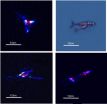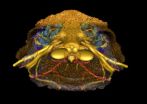(Press-News.org) A Johns Hopkins study of patients with ischemic stroke suggests that many of those who receive prompt hospital treatment with "clot-busting" tissue plasminogen activator (tPA) therapy can avoid lengthy, restrictive monitoring in an intensive care unit (ICU).
The study challenges the long-standing protocol that calls for intensive monitoring, mostly done in ICUs, for the first 24 hours after tPA infusion to catch bleeding in the brain, a side effect seen in 6 percent of patients treated with the medication.
Results show that a relatively simple measure of stroke severity can accurately single out which patients need ICU monitoring and which can be managed outside of a critical care setting in the hospital.
"What we saw in this preliminary study was that, after the initial hour-long infusion of tPA, if an intensive care need had not developed, the chance of needing ICU monitoring - including a symptomatic 'bleed' - was extremely low for a large majority of patients, namely those with milder strokes," says Victor Urrutia, M.D., medical director of the Comprehensive Stroke Center at The Johns Hopkins Hospital and head of the research team.
Ischemic stroke, caused by a clot in a blood vessel that cuts off blood flow to the brain, is the most common form of stroke and the second leading cause of death for those over 60. In the United States, an estimated 795,000 people suffer a stroke each year. So far, tPA is the only FDA-approved treatment for acute stroke.
In a report on the study published online in the journal PLOS ONE, the Johns Hopkins team analyzed data from 153 stroke patients admitted to the emergency departments of The Johns Hopkins Hospital and Johns Hopkins Bayview Medical Center between 2010 and 2013. After taking into account differences in age, sex, race, hypertension, diabetes, atrial fibrillation, kidney function, blood clotting status, use of statin drugs and other health factors, the team says that what emerged as the best predictor of the need for intensive care was a patient's score on the National Institutes of Health (NIH) Stroke Scale, a trusted measure of stroke severity. The scale is a proven tool administered at the bedside involving 15 measures and observations, including level of consciousness, language ability, eye movements, vision strength, coordination and sensory loss. Scores range from zero to 42, with mild strokes typically registering 10 or lower. The average score for the Johns Hopkins patient group was 9.8.
"What we learned is that the majority of our patients with mild strokes required no critical care, and that we are using scarce, specialized resources for intensive monitoring rather than for intensive care," says Urrutia, an assistant professor of neurology.
"If our upcoming, prospective study verifies what we've found about those who don't need to be in the ICU, our patients will benefit, and we will also reduce costs of care."
Urrutia emphasized that critical care is clearly needed for tPa-linked bleeding, stroke-related brain swelling and critical abnormalities in blood pressure or blood sugar.
But, he says, "For patients with an NIH Stroke Scale score of less than 10 without a need for transfer to the ICU after the first hour, the risk of a problem occurring later that needed ICU attention was only about 1 percent."
In the follow-up study, which is scheduled to begin this spring, consenting patients with a low stroke scale score and no other apparent need for intensive care will enter a stroke unit with a less rigorous monitoring schedule and increased family visiting time.
Patients in the non-ICU setting will be less physically restricted and subjected to fewer sleep interruptions, lowering the risk of ICU-associated delirium and psychological distress. "We expect benefits to extend to the hospital as well, freeing up the ICU staff and beds for sicker patients," says Urrutia.
The financial benefits of the change in protocol could be significant, Urrutia adds. "Present monitoring for patients with tPA is very costly," he says.
INFORMATION:
Other Johns Hopkins researchers on the team include first author Roland Faigle, M.D.; Anjail Sharrief, M.D.; Elizabeth B. Marsh, M.D.; and Rafael Llinas, M.D.
The research was supported in part by a Research and Education Program for Residents and Fellows in Neurology and Neurosurgery sponsored by the National Institutes of Health's National Institute of Neurological Disorders and Stroke (R25NS065729).
For more information about stroke care at Johns Hopkins, click here.
Johns Hopkins Medicine (JHM), headquartered in Baltimore, Maryland, is a $6.7 billion integrated global health enterprise and one of the leading academic health care systems in the United States. JHM unites physicians and scientists of the Johns Hopkins University School of Medicine with the organizations, health professionals and facilities of The Johns Hopkins Hospital and Health System. JHM's vision, "Together, we will deliver the promise of medicine," is supported by its mission to improve the health of the community and the world by setting the standard of excellence in medical education, research and clinical care. Diverse and inclusive, JHM educates medical students, scientists, health care professionals and the public; conducts biomedical research; and provides patient-centered medicine to prevent, diagnose and treat human illness. JHM operates six academic and community hospitals, four suburban health care and surgery centers, and more than 35 Johns Hopkins Community Physicians sites. The Johns Hopkins Hospital, opened in 1889, was ranked number one in the nation for 21 years in a row by U.S. News & World Report. For more information about Johns Hopkins Medicine, its research, education and clinical programs, and for the latest health, science and research news, visit http://www.hopkinsmedicine.org.
Media Contacts:
Stephanie Desmon
410-955-8665; sdesmon1@jhmi.edu
Lauren Nelson
410-955-8725; lnelso35@jhmi.edu
Many stroke patients on 'clot-busting' tPA may not need long stays in the ICU
New Johns Hopkins study suggests test can indicate if intensive care is necessary
2014-02-13
ELSE PRESS RELEASES FROM THIS DATE:
Whales viewed from space
2014-02-13
High-resolution satellite images may be a useful tool for counting whale populations for conservation purposes, according to a study published in PLOS ONE on February 12, 2014 by Peter Fretwell from British Antarctic Survey, UK, and colleagues.
In the study, the authors selected one of the largest southern right whale populations, breeding off the Argentinian coast. The population was selected, due to its large size and tendency to bask near the surface in large aggregations around sheltered coastal waters during breeding season. Scientists used this population to test ...
Mathematical beauty activates same brain region as great art or music
2014-02-13
People who appreciate the beauty of mathematics activate the same part of their brain when they look at aesthetically pleasing formula as others do when appreciating art or music, suggesting that there is a neurobiological basis to beauty.
There are many different sources of beauty - a beautiful face, a picturesque landscape, a great symphony are all examples of beauty derived from sensory experiences. But there are other, highly intellectual sources of beauty. Mathematicians often describe mathematical formulae in emotive terms and the experience of mathematical beauty ...
Two strategies for accurate dart throwing
2014-02-13
Timing of dart release or hand position may improve dart throwing accuracy, according to a study published in PLOS ONE on February 12, 2014 by Daiki Nasu from Osaka University, Japan and colleagues.
Two major strategies are attributed to accurate throwing: timing the object release, and the using hand positioning at release to compensate for releasing the object at variable times. To better understand these strategies, researchers investigated whether expert dart players utilize hand movement that can compensate for the variability in their release timing. The study compared ...
Ancient reptile birth preserved in fossil
2014-02-13
Ichthyosaur fossil may show the earliest live birth from an ancient Mesozoic marine reptile, according to a study published February 12, 2014 in PLOS ONE by Ryosuke Motani from the University of California, Davis, and colleagues.
Ichthyosaurs were giant marine reptiles that evolved from land reptiles and moved to the water. Scientists report a new fossil specimen that belongs to Chaohusaurus (Reptilia, Ichthyopterygia), the oldest of Mesozoic marine reptiles that lived approximately 248 million years ago. The partial skeleton was recovered in China and may show a live ...
Satellites help spot whales
2014-02-13
Scientists have demonstrated how new satellite technology can be used to count whales, and ultimately estimate their population size. Using Very High Resolution (VHR) satellite imagery, alongside image processing software, they were able to automatically detect and count whales breeding in part of the Golfo Nuevo, Peninsula Valdes in Argentina.
The new method, published this week in the journal PLoS ONE, could revolutionise how whale population size is estimated. Marine mammals are extremely difficult to count on a large scale and traditional methods, such as counting ...
Brain process takes paper shape
2014-02-13
A paper-based device that mimics the electrochemical signalling in the human brain has been created by a group of researchers from China.
The thin-film transistor (TFT) has been designed to replicate the junction between two neurons, known as a biological synapse, and could become a key component in the development of artificial neural networks, which could be utilised in a range of fields from robotics to computer processing.
The TFT, which has been presented today, 13 February, in IOP Publishing's journal Nanotechnology, is the latest device to be fabricated on paper, ...
Doctors are missing chance to diagnose COPD in up to 85 percent of cases, study finds
2014-02-13
A retrospective, 20-year study led by researchers at Plymouth University Peninsula Schools of Medicine and Dentistry shows that in up to 85 per cent of patients with chronic obstructive pulmonary disease (COPD) the underlying disease was being overlooked. Missed opportunities occur commonly in both primary and secondary care. The paper demonstrates the pointers to help GP to come to a earlier diagnosis. The findings are published in The Lancet Respiratory Medicine today, Thursday 13th February 2014.
The study encompassed almost 39,000 patients and showed that, in the ...
Cancer researchers discover pre-leukemic stem cell at root of AML, relapse
2014-02-13
(TORONTO, Canada – Feb. 12, 2014) – Cancer researchers led by stem cell scientist Dr. John Dick have discovered a pre-leukemic stem cell that may be the first step in initiating disease and also the culprit that evades therapy and triggers relapse in patients with acute myeloid leukemia (AML).
The research, published online today in Nature is a significant leap in understanding the steps that a normal cell has to go through as it turns into AML, says Dr. Dick, and sets the stage to advance personalized cancer medicine by potentially identifying individuals who might benefit ...
Jaw dropping: scientists reveal how vertebrates came to have a face
2014-02-13
A team of French and Swedish researchers have presented new fossil evidence for the origin of one of the most important and emotionally significant parts of our anatomy: the face. Using micron resolution X-ray imaging, they show how a series of fossils, with a 410 million year old armoured fish called Romundina at its centre, documents the step-by-step assembly of the face during the evolutionary transition from jawless to jawed vertebrates. The research is published in Nature on 12 February 2014.
Vertebrates, or backboned animals, come in two basic models: jawless and ...
Advanced techniques yield new insights into ribosome self-assembly
2014-02-13
CHAMPAIGN, Ill. — Ribosomes, the cellular machines that build proteins, are themselves made up of dozens of proteins and a few looping strands of RNA. A new study, reported in the journal Nature, offers new clues about how the ribosome, the master assembler of proteins, also assembles itself.
"The ribosome has more than 50 different parts – it has the complexity of a sewing machine in terms of the number of parts," said University of Illinois physics professor Taekjip Ha, who led the research with U. of I. chemistry professor Zaida Luthey-Schulten and Johns Hopkins University ...
LAST 30 PRESS RELEASES:
New expert guidance urges caution before surgery for patients with treatment-resistant constipation
Solar hydrogen can now be produced efficiently without the scarce metal platinum
Sleeping in on weekends may help boost teens’ mental health
Study: Teens use cellphones for an hour a day at school
After more than two years of war, Palestinian children are hungry, denied education and “like the living dead”
The untold story of life with Prader-Willi syndrome - according to the siblings who live it
How the parasite that ‘gave up sex’ found more hosts – and why its victory won’t last
When is it time to jump? The boiling frog problem of AI use in physics education
Twitter data reveals partisan divide in understanding why pollen season's getting worse
AI is quick but risky for updating old software
Revolutionizing biosecurity: new multi-omics framework to transform invasive species management
From ancient herb to modern medicine: new review unveils the multi-targeted healing potential of Borago officinalis
Building a global scientific community: Biological Diversity Journal announces dual recruitment of Editorial Board and Youth Editorial Board members
Microbes that break down antibiotics help protect ecosystems under drug pollution
Smart biochar that remembers pollutants offers a new way to clean water and recycle biomass
Rice genes matter more than domestication in shaping plant microbiomes
Ticking time bomb: Some farmers report as many as 70 tick encounters over a 6-month period
Turning garden and crop waste into plastics
Scientists discover ‘platypus galaxies’ in the early universe
Seeing thyroid cancer in a new light: when AI meets label-free imaging in the operating room
Neutrophil-to-lymphocyte ratio may aid risk stratification in depressive disorder
2026 Seismological Society of America Annual Meeting
AI-powered ECG analysis offers promising path for early detection of chronic obstructive pulmonary disease, says Mount Sinai researchers
GIMM uncovers flaws in lab-grown heart cells and paves the way for improved treatments
Cracking the evolutionary code of sleep
Medications could help the aging brain cope with surgery, memory impairment
Back pain linked to worse sleep years later in men over 65, according to study
CDC urges ‘shared decision-making’ on some childhood vaccines; many unclear about what that means
New research finds that an ‘equal treatment’ approach to economic opportunity advertising can backfire
Researchers create shape-shifting, self-navigating microparticles
[Press-News.org] Many stroke patients on 'clot-busting' tPA may not need long stays in the ICUNew Johns Hopkins study suggests test can indicate if intensive care is necessary




